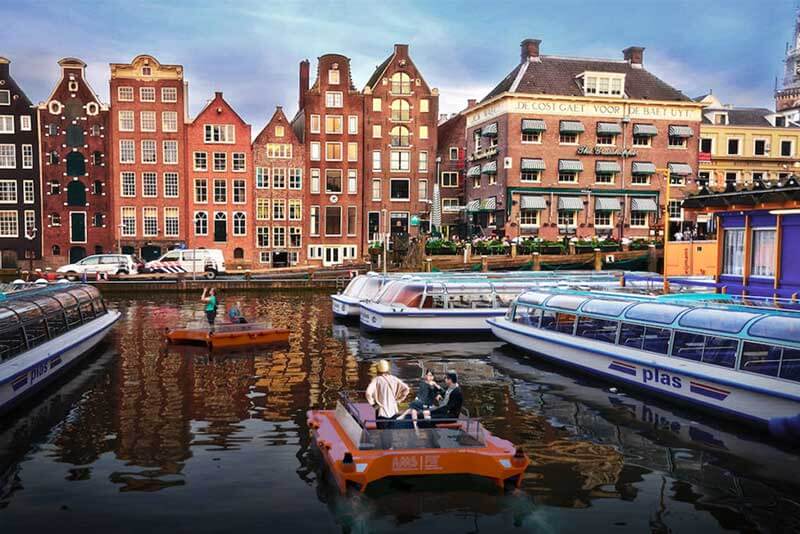- Robotic boats might soon be floating through Amsterdam’s canals
- Researchers have already successfully tested quarter-scale prototypes
- An opportunity to solve transportation, mobility and water quality issues
Traffic congestion is one of the biggest problems associated with life in today’s cities. And as the world’s urban population continues to grow, the problem is only going to get worse in the future. According to the INRIX 2017 Global Traffic Scorecard study, which analysed the impact of traffic congestion in more than 1,360 cities in 38 countries of the world, the US is the world’s most congested country, with drivers spending an average of 41 hours per year in traffic jams. The estimated cost of congestion was $305 billion, which represents a $10 billion increase from the previous year. This figure is based on various factors, including productivity loss from workers sitting in their cars, fuel wasted by vehicles idling in traffic, and higher costs of transporting goods through congested areas.
“Combined with the rising price of motoring, the cost of congestion is astonishing – it takes billions out of the economy and impacts businesses and individuals alike,” says Graham Cookson, the chief economist at INRIX. “With the Office of National Statistics showing more cars on the road than ever before, we need to consider innovative new approaches to solving the issue.” For cities with an abundance of waterways, those very waterways could offer a solution to this problem and help the authorities ease congestion by diverting a portion of the traffic load towards them.
Robotic boats might soon be floating through Amsterdam’s canals
Amsterdam is one of those cities, with water covering nearly a quarter of its surface. Featuring an intricate, 1000-kilometre-long network of canals and more than 1,500 bridges, Amsterdam has been chosen as testing ground for a fleet of self-driving robotic boats, or ‘Roboats’, which would be used to transport people and goods around the city. “We would like to adapt the same benefits that we potentially see in autonomous vehicles for waterways and for cities that are built on waterways,” explains Daniela Rus, the director of the computer science and artificial intelligence laboratory at MIT and one of the researchers on the project. “We believe that with fleets of very agile autonomous boats we can offload some street traffic onto the waterways.”

In addition to transporting people and goods, the Roboats could also be programmed to assemble themselves into temporary floating infrastructure, such as bridges, markets, or concert stages. Once those structures are no longer needed, the boats would disassemble again and go back to their transporting duties. Furthermore, the Roboats could also be used to collect information about water quality, detect diseases, or clear waste from the city’s canals.
Researchers have already successfully tested quarter-scale prototypes
The project is a collaboration between MIT and the Amsterdam Institute for Advanced Metropolitan Solutions (AMS Institute), with further assistance provided by the Delft University of Technology (TU Delft) and Wageningen University and Research (WUR). The project will last for five years and has been awarded a budget of €25 million. The researchers have built quarter-scale prototypes, which have been successfully tested in Amsterdam’s canals.
The prototype boats feature a 180-centimetre-long and 75-centimetre-wide 3D-printed rectangular hull and are equipped with four electric thrusters for propulsion, a Wi-Fi antenna, GPS gear, a minicomputer and a microcontroller. The position of the thrusters – which are located in the centre of each side – allows the boat to generate both forward and backward forces. This makes the boat more agile and allows it to move in all directions. Furthermore, there are built-in ultrasound beacons and docking systems, allowing the Roboats to line up precisely and link with one another. They also use a variety of sensors to scan their surroundings, similar to the way autonomous cars work. The information is then fed into the on-board AI system, which analyses it to calculate the optimal route.
An opportunity to solve transportation, mobility and water quality issues
“Amsterdam’s waters, including bridges, canals, and the river and its docks, offer plenty of opportunity to help solve current issues with transportation, mobility, and water quality”, says Carlo Ratti, a professor at MIT and the principal investigator in the project. “With 80% of global economic output generated around coasts, riverbanks, and deltas and 60% of the world population living in these areas, outcomes from the Roboat projects could become a reference for other urban areas around the world.”
However, some industry experts are a bit skeptical about the project. Even with the existence of suitable waterways in their vicinity, it may not be easy for cities to redirect their waste management and cargo deliveries from roads to waterways. “I think it does have some promise”, says Norman Garrick, a civil engineer at the University of Connecticut who specialises in sustainable city transport. “But like a lot of these things, it will depend a lot on the context and the execution”.
As the urban population continues to grow, so does the number of cars on our roads, exacerbating traffic congestion. Governments around the world have been looking for ways to ease the congestion, but most of those efforts have proven fruitless. For cities like Amsterdam, which were built on waterways, those same waterways could be a part of the solution. By redirecting some of the traffic towards them, they could ease the congestion on nearby roadways and improve the quality of life in those cities.
Share via:


